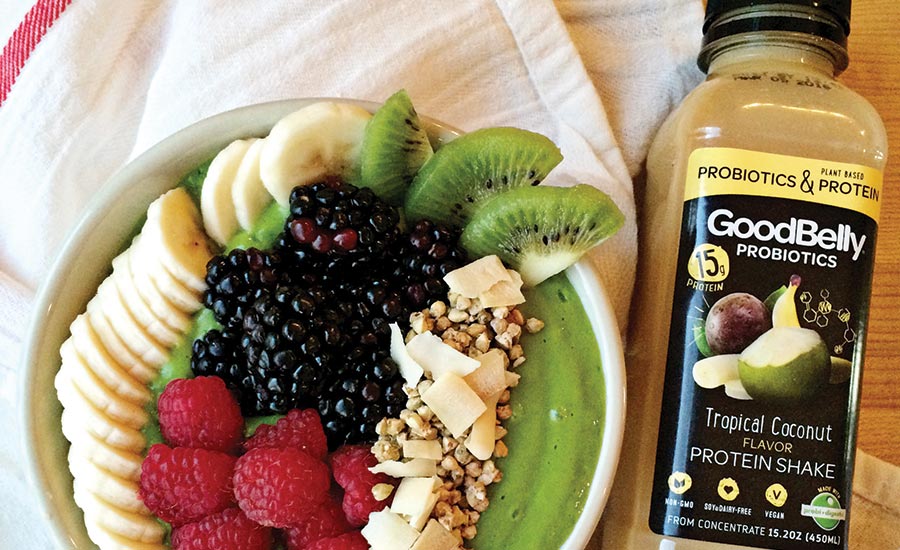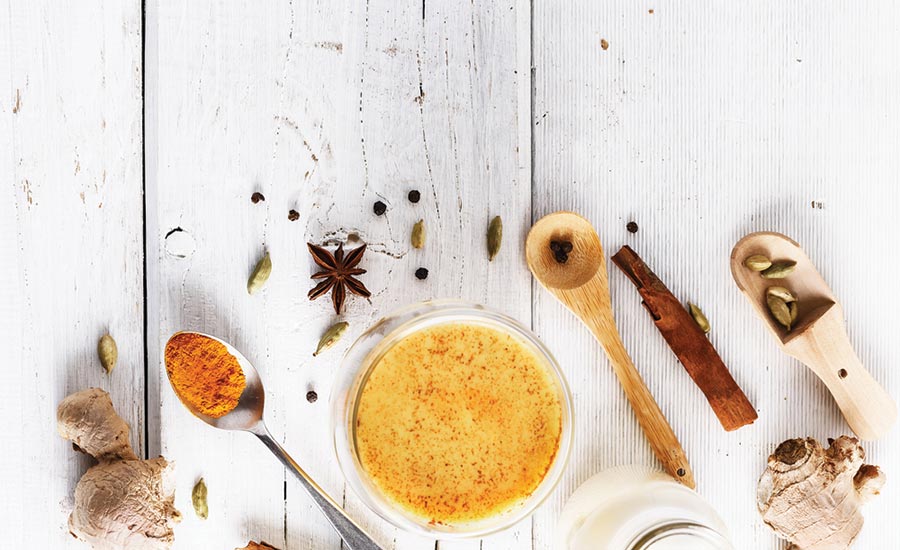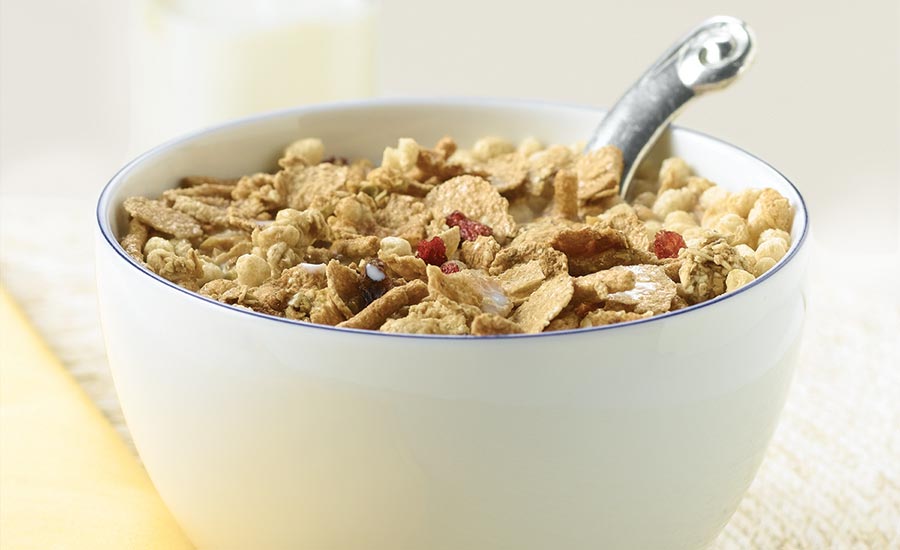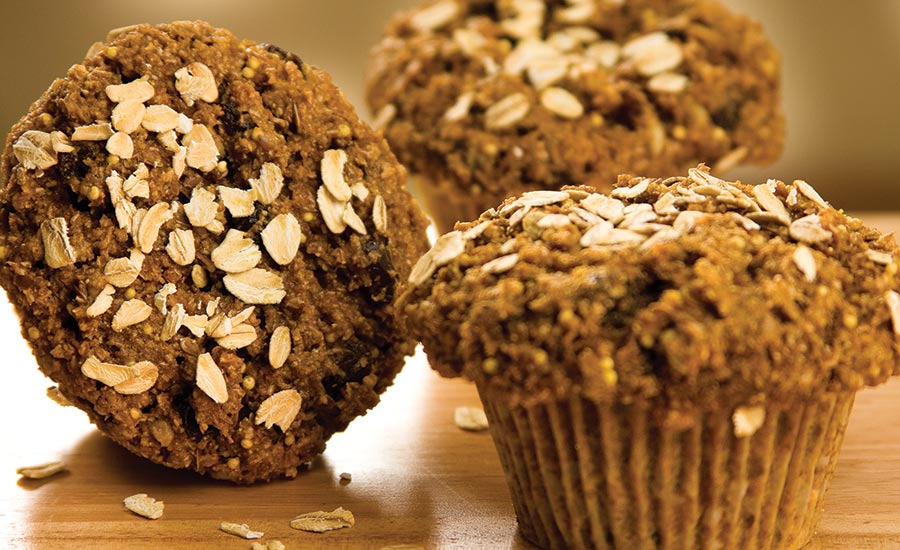America’s appetite for gut-friendly products continues to be ravenous. Consumers are eagerly seeking foods and beverages that help them maintain a healthy digestive tract. This is also evidenced by GoogleTrends. Recent data from Google revealed that the number of US web searches for “improving gut health” increased 250% in the past year alone.
Connected to and helping to drive this interest in the digestive tract is the expanding consumer awareness that having a healthy gut means more than just being regular. The science uncovering the connections between digestive health and both immunity and mental health/well-being has created a generation of tuned-in consumers as well. According to the aforementioned Google analytics, interest in “anxiety and gut health” rose 200%, suggesting that individuals have a growing curiosity about how gut health affects the brain.
Health-conscious consumers will-ingly and experimentally modify their diets in search of solutions to bloating, indigestion, constipation, low energy levels, and weight issues. Mounting evidence suggests the gut and its community of microbes act as the internal switchboard connecting one’s diet to manifested feelings that go beyond the stereotypical and once taboo-to-discuss function of bowel movements.

Probiotic bacteria remain the ingredients that consumers associate most strongly with digestive health and overall wellness.
PHOTO COURTESY OF: Next Foods Inc./GoodBelly (www.goodbelly.com)
Thanks to candid social media influencer-led conversations and health practitioner recommendations, consumer interest in digestive health products continues to become part of the entire health experience. This paradigm shift into the mainstream has opened the door for functional foods and beverages to specifically target the lower g.i. tract.
Ingredients such as prebiotics, probiotics, and fiber have achieved widespread usage in functional foods in recent years. They also, in turn, have fostered greater research into new ingredients and new varieties of the tried-and-true ingredients for better digestive health. Some of the ingredients attracting attention in recent years merit closer examination.
Guar Fiber
Guar fiber is one of only a handful of fibers approved for its physiological benefits by the FDA. With more than 120 recently published clinical studies behind it, guar fiber has a recognized track record for bringing balance to the digestive tract.
Some of the documented health benefits range from relief of occasional constipation and diarrhea to active prebiotic effects and management of blood sugar, hunger, and cholesterol. Studies also show that guar fiber delivers these benefits without the undesirable side effects common to some other dietary fibers, such as excessive gas, abdominal cramps, and bloating.
As a prebiotic, guar fiber has a positive effect on the gut microbiome, as several clinical studies have shown. Guar fiber promotes the proliferation of beneficial Bifidobacteria and Lactobacillus bacteria, and diminishes negative or harmful bacteria in the gut.
Guar fiber has been used in products for more than 25 years and has a long history of safety and efficacy. Guar fiber is one of the only low fermentable oligo-, di-, and mono-saccharides and polyols (FODMAP) soluble fibers (Monash University Low FODMAP certified).
One new product on the market containing guar fiber is a tasteless and odorless powder by Regular Girl. The powder is a blend containing 5g guar fiber along with probiotics from the Bifidobacteria lactis strain. The powder can be added to beverages or stirred into foods.
When added to water or other clear liquids, the Regular Girl product dissolves completely, without clouding. Because guar fiber is stable across a wide range of temperatures, pH, and freeze-thaw cycles, it is able to maintain shelflife and effectiveness in numerous food and beverage products.
Go Psycho
The gut-brain axis is an emerging area of research that focuses on the connection between the gut microbiome and its impact on the central nervous system and psychiatric disease. Researchers are working hard to better understand the mechanisms by which gut microbes impact neurological health, including actions on the vagus nerve, interactions with digestive metabolites, balancing of fatty acids, gut hormone signaling, and immune responses.
“There is a bidirectional communication between the gut microbiota and the brain, maintained by endocrine and neurocrine mechanisms,” Suravi Patra, MD, of the Department of Psychiatry at the All-Indian Institute of Medical Sciences, Delhi, explained in an article published in the Indian Journal of Pharmacology. “The brain can influence the microbiota composition, while the intestinal microbiota can influence brain neurotransmitter levels with consequent effects on emotions, behavior, and pain.”
Arising out of this growing knowledge about the gut-brain axis is a new concept in “better for you” ingredients: psychobiotics. Psychobiotics could be a new avenue for capitalizing on this synergy in digestive health. Defined as “bacteria, which when ingested confer health benefits in patients with psychiatric diseases,” these microorganisms exhibit anti-inflammatory effects similar to other probiotics, but they also produce neurotransmitters such as serotonin and gamma-aminobutyric acid (GABA).

For centuries, traditional medicine recognized the importance of digestive health and uncovered botanicals that help. Today, science is supporting this knowledge.
PHOTO COURTESY OF: Arjuna Natural Extracts Ltd./DolCas Biotech LLC; (www.dolcas-biotech.com)
It is believed that the influence of microbes on serotonin and GABA levels in the gut affects brain chemistry. Cells in the g.i. tract called “enterochromaffin cells” produce approximately 90% of the serotonin in the human body. Serotonin also is secreted by some species of Enterococcus and Escherichia, whereas GABA is produced by Lactobacillus and Bifidobacterium.
Serotonin is a neuroactive compound well-known and studied for its effects on mental and emotional health and well-being. But serotonin also plays a role in digestive health. Scientists studied the effects of Lactobacillus acidophilus and Bifidobacterium longum on the level of serotonin transporter mRNA in intestinal epithelial cells in vitro. It turns out that a balance between the release and inactivation of serotonin is required to achieve equilibrium in the gut.
Research revealed that serotonin levels are different in patients with irritable bowel syndrome (IBS) with predominant constipation versus patients with IBS with predominant diarrhea. Serotonin transporters, which inactivate serotonin, were upregulated in cells treated with probiotics.
These connections led to reviews of the potential of psychobiotics. It has been noted that treatment with probiotics is physiologically and psychologically beneficial in patients with disorders such as IBS and Crohn’s disease, as often there is comorbidity with anxiety and depression.
While most of the work on the mechanisms of psychobiotics has been elucidated by animal studies, a number of human clinical trials have shown promise for probiotics and improvement of mood. While many of the human studies look at the effects on persons with digestive health issues, one study, published in the British Journal of Nutrition, examined the effects of Lactobacillus helveticum R0052 and Bifidobacterium longum R0175 in healthy human volunteers. The researchers found the probiotic treatment provided measurable benefit countering general signs of anxiety and depression.
Preliminary results from a double- blind randomized study conducted at the University of Rome-Tor Vergata showed that probiotics can have a positive impact on the mental well-being of women who are obese or suffer from normal weight obese syndrome (NWO), described as having a normal body-mass index but with higher total body fat and lower total body lean mass.
Women enrolled in the study took a probiotic suspension containing various lactic acid bacteria species from the genera Bifidobacterium, Lactobacillus, Lactococcus, and Streptococcus. After three weeks on the probiotic, the NWO and preobese/obese groups had a statistically significant lower BMI and fat mass.
Psychopathological scores and eating behavior for both groups also were improved. Because the sample size was small, more studies with larger groups are needed to verify the results, but the initial results are promising enough to consider such probiotic applications for future food formulations.
Since GABA is a popular supplement on its own, it is worthwhile to consider whether food formulators should formulate with probiotics, ingredients such as GABA, or a combination of the two. It also is worth noting that certain common compounds in foods are converted, in small amounts, into serotonin and melatonin, a sleep regulating neurotransmitter, in the gut.
Suitable gut microbes have the potential to be genetically engineered in the future to metabolize tryptophan in specific ways to benefit consumers. The interplay of bacteria and neurologically significant compounds opens many possibilities for future food products.
A Little S’more
Both herbal/folk medicine and functional foods provide methods of interacting with the gut microbiome. Popular botanicals for digestive health have included such flavorful, phytochemical-filled ingredients as fennel, ginger, mint, and chamomile.
As science keeps dipping back into the traditional medicine well, other botanicals are moving into the limelight. Marshmallow (Althaea officinalis) root and flower extracts are examples of emerging ingredients for formulators seeking compounds that help maintain a healthy gut with a beneficial balance of good microbes.
Marshmallow, commonly found in the Middle East, is often prescribed in that part of the world for relief from inflammation and gastritis. The plant has been used in Europe for relief from irritation of mucous membranes and cough.

Interest in such gut-health ingredients as inulin and fructooligosaccharides is high, but awareness of digestion in maintaining overall health is just starting to grow.
PHOTO COURTESY OF: Beneo Inc. (www.beneo.com)
A recent study conducted at the University of Müenster, Germany, assessed the effects of aqueous extract and raw polysaccharides from marshmallow root in vitro. The extract was found to stimulate epithelial cell activity and proliferation. The study also revealed that the raw polysaccharides were adsorbed onto the cell surface of fibroblasts, the cells that are key players in wound healing, cell and extracellular matrix structure, and collagen building.
New animal studies have examined the effects of marshmallow flowers. A water extract of the flower was given at various doses and found to have meaningful effects on various biological markers. These included increased serum high-density lipoprotein (HDL) cholesterol, decreased liver enzyme activity, protection against ulcers induced by ethanol, and anti-inflammatory activity.
A later animal study confirmed the protection marshmallow flower extract confers against gastric ulcers. This experiment observed the effects of aqueous extracts of both marshmallow flower and ginger on subjects with indomethacin-induced ulcers.
The researchers proposed that the protective mechanism of the extracts is due to their antioxidant properties.
Polyphenols and Antioxidants
It has long been postulated that a diet high in fruits and vegetables contributes to better overall health. Taking advantage of the fibers, polysaccharides, and polyphenols present in fruits, vegetables, and grains is another way to marry herbal medicine with functional food.
In recent years, much research has been performed on polyphenols and antioxidants as they relate to better health, including digestive health. The related forms of polyphenols known as anthocyanins, procyanidins, and proanthocyanidins (PACs), are found in several plant-based foods, including berries, cereals, chocolate, wine, and tea.
PACs exhibit bioactivity beneficial to human health, including antioxidant activity, diabetes prevention (via participation in glucose homeostasis), anti-inflammatory activity, antimicrobial action against pathogens, and inhibition of carcinogenesis. These diseases and dysfunctions are interlinked with gut health.

Popular botanicals for digestive health with a history of appeal to consumers include fennel, ginger, mint, and chamomile.
PHOTO: The Hain Celestial Group/ Celestial Seasonings Inc. (www.celestialseasonings.com)
A recent review regarding the use of functional foods and herbal medicine to treat and prevent diseases, published in Frontiers in Microbiology, highlighted the significance of apple procyanidins. A study in Scientific Reports demonstrated that mice fed a diet high in sucrose and fat gained less weight and had decreased inflammation when fed highly polymeric apple procyanidins.
Scientists at the USDA determined that purple and red rice bran extracts containing anthocyanins and PACs increased glucose uptake in mouse adipocytes (fat cells), suggesting the extracts assist glucose homeostasis and aid diabetes management. Both of those conditions are known to impact digestive health.
PACs from cinnamon also gained attention in the last decade for their anti-diabetic potential. Because polyphenolic compounds are sometimes bitter, incorporating them into finished products can be problematic. Scientists at the Universidade de São Paulo in Brazil recently published a study showing that spray chilling can be used to add PACs from cinnamon into solid lipid microparticles.
Vegetable fat was used as the carrier for the bioactive compounds. Using such a lipid base can result in stability lasting up to 90 days. The spray-chilling process also can mask astringent or bitter notes sometimes associated with cinnamon PACs.
Ingredient Update
While the use of ingredients such as probiotics, fibers, resistant starches, and inulin for functional food formulations is not a new concept, research continues to build support for these important ingredients.
A recent study examined the probiotic potential of Enterococcus hirae F2, a lactic acid bacteria strain found in the gut of Indian major carp fish. The study showed these bacteria survived simulated digestion, inhibited pathogens such as Staphylococcus aureus and Salmonella typhi, and had the ability to form curd, which could be helpful in yogurt and other probiotic dairy applications.
Last month, the FDA announced that chicory root fibers— including inulin, inulin-type fructans, and oligofructose— will be on the new list of approved dietary fibers and may be labeled as dietary fibers on the Nutrition Facts panel.
Inulin, a fructan polysaccharide, and fructooligosaccharide (also called “oligofructose” or “oligofructan”), are both widely utilized prebiotic fibers in a variety of market segments. Commonly derived from chicory root and other sources, they have a solid record of benefits for gut health.
A recently published study from the University of Memphis, TN, conducted on adult volunteers by Randal Buddington, PhD, of the University of Tennessee Health Sciences Center, demonstrated that daily supplementation of 15g of oligofructose from chicory root significantly balanced digestion while being well-tolerated.
With most of the US ingesting half or less than half of the 25g minimum daily recommendation for fiber, such ingredients are a boon to both consumers and the product developers wishing to help them meet these needs from just a few sources during the course of the day.
These fibers incorporate easily into products such as baked goods and smoothies, and even confections such as chocolate. They contribute a slight sweetness to a formulation, but with only about a third of the calories of sugar, flour, or starch. They work especially well in conjunction with high-intensity sweeteners to mask off tastes and round out the sweetness profile.
Inulin also can be sourced from agave. A study in the Journal of Nutrition showed agave inulin supplementation at 7.5g per day (a level previously determined by the same researchers to be well-tolerated in humans) increased fecal Bifidobacterium content and total dietary fiber consumed by the study participants correlated positively with fecal butyrate levels.
Microbe Food
Beneficial probiotic bacteria in the lower g.i. tract feed off of the prebiotic fibers and generate the short-chain fatty acid (SCFA) butyrate. Butyrate serves as the preferred energy source for epithelial cells in the colon.
Butyrate and other SCFAs, as metabolites of prebiotics in the gastrointestinal tract, have been implicated in health benefits such as fluid and electrolyte uptake regulation and anti-inflammatory responses. Arabinoxylans, another fiber type found in the cell wall of wheat grain, have been shown to exert immunomodulatory effects via interactions with gut bacteria.
Resistant starch has benefited from the new surge in interest in digestive health. More processors and product developers are turning to the ingredient for its ability to work on multiple levels in formulations and in the body. Resistant starch, too, is a fermentable carbohydrate that generates butyrate and other SCFAs.

Boosting whole-grain fiber with functional fibers such as guar gum helps enhance the healthful benefits in baked items without creating dense textures.
PHOTO COURTESY OF: Regular Girl (www.regulargirl.com)
In the body, resistant starch performs several beneficial functions. Per its name, it is resistant to digestion, so it makes its way to the colon, acting as a fiber to regulate collection and movement of materials for expulsion and helping clear the body of potentially deleterious substances.
Dozens of research studies back the efficacy of resistant starch in helping to improve digestive function, balance blood sugar, manage weight, and increase satiety, both through the physical actions of its fiber-like capacity, and chemically via stimulation of satiety hormones.
In formulations such as baked foods, resistant starch can replace up to 25% of wheat flour while not only maintaining the structure and rising capacity, but also helping risen items by adding a few more percent volume. Resistant starch can help with clean label formulations, as it can be labeled simply as starch from its source.
As evidenced here, there are several ingredients, both old and new, that food formulators can utilize to create science-backed healthful products for today’s digestive-savvy consumers. The toolbox for foods aimed at digestive health will no doubt continue to increase as research continues to explore the interaction of new probiotics and botanicals with the gut microbiome.
As science helps to better understand the mechanism of how fibers and polysaccharides interact with the gut and other organ systems, formulators will have the ability to create food products that deliver benefits for digestive health and the holistic health it has come to represent.
Originally appeared in the July, 2018 issue of Prepared Foods as Gut Check Time.

